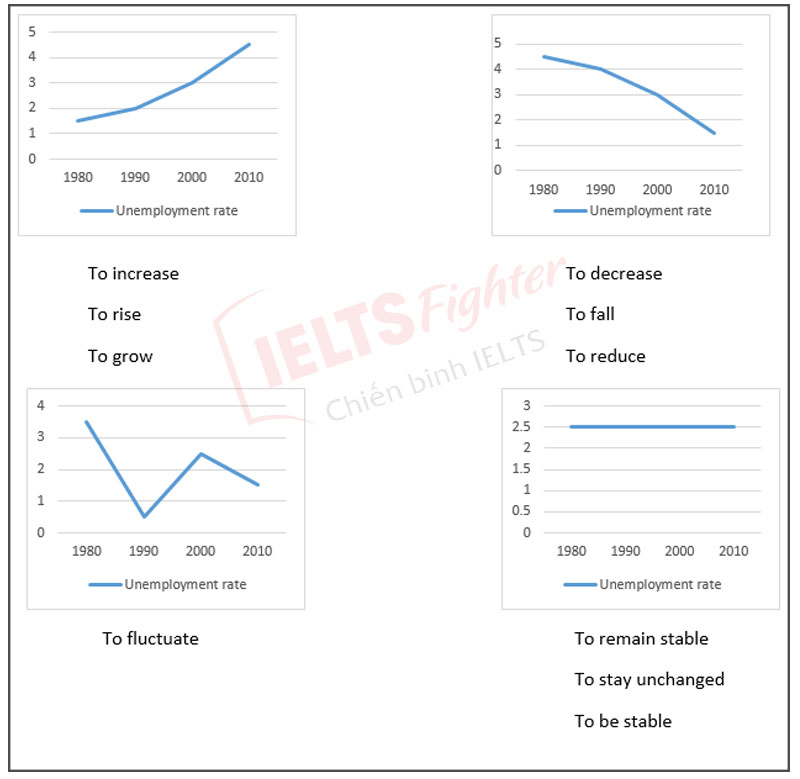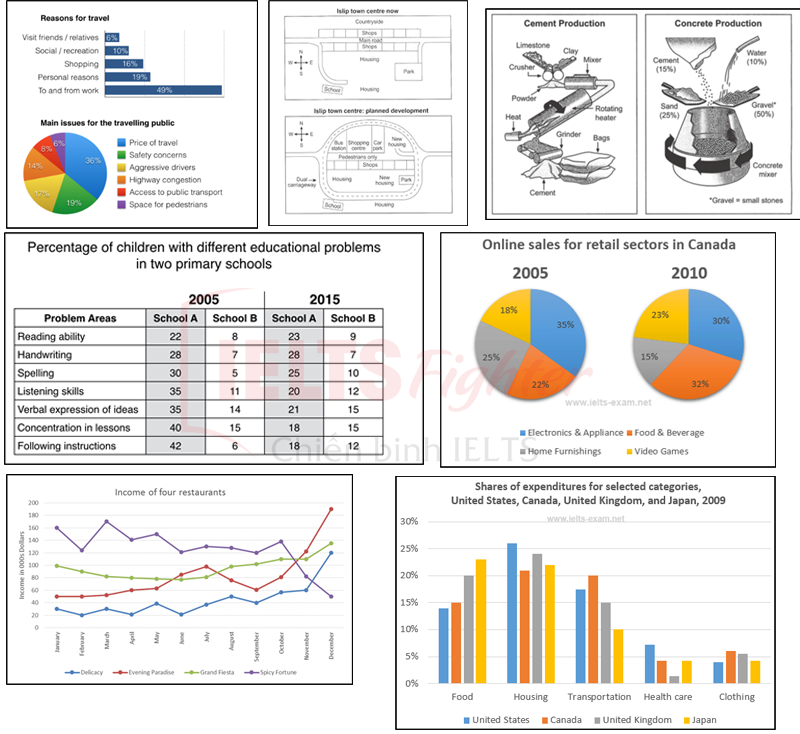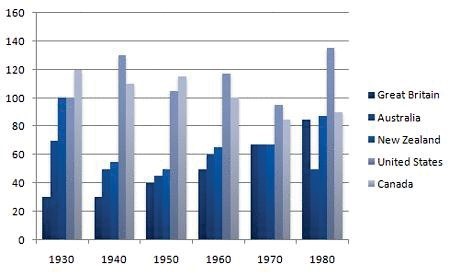Khi bắt đầu học IELTS Writing thì các bạn đều cần chuẩn bị cho mình những nguyên liệu cần thiết để nâng cao kiến thức. Nào hãy bắt đầu cùng tìm kiếm những từ vựng + ngư pháp quan trọng cho bài thi của mình nhé.
Từ vựng IELTS Writing Task 1
1. Miêu tả sự thay đổi

Từ vựng:
| Xu hướng (Trend) | Động từ (Verb) | Danh từ (Noun) |
| Xu hướng tăng | - increase - rise - grow - go up - climb | - increase - rise - growth - upward trend |
| Xu hướng tăng mạnh | - rocket - soar - leap - jump | - rocket - soar - leap - jump |
| Xu hướng giảm | - decrease - fall/fall down - go down - reduce - decline - drop | - decrease - fall - downward trend - reduction - decline - drop |
| Xu hướng giảm mạnh | - plunge - slump - dive - plummet - dip | - plunge - slump - dive - plummet - dip |
| Xu hướng tăng giảm bất thường | - fluctuate - oscillate | - fluctuation - variation |
| Xu hướng ổn định | - remain/stay stable - remain/stay unchanged - stabilize - to be unchanged | - stabilty |
| Đạt mức cao nhất | - reach a peak - reach/hit the highest point | |
| Đạt mức thấp nhất | - reach/hit the lowest point - fall to a low - reach a bottom |
Các từ vựng tả mức độ thay đổi
Thay đổi rất lớn - Great change / Huge difference:
- Adjectives Adverbs
- Overwhelming Overwhelmingly
- Substantial Substantially
- Enormous Enormously
Thay đổi lớn - Big change / Big difference:
- Adjectives Adverbs
- Significant Significantly
- Considerable Considerably
Thay đổi trung bình - Medium change / Moderate difference:
- Adjectives Adverbs
- Somewhat Somewhat
- Moderate Moderately
Thay đổi nhỏ - Minor change / Small difference:
- Adjectives Adverbs
- Fractional Fractionally
- Marginal Marginally
- Slight Slightly
2. Từ vựng miêu tả tốc độ thay đổi
| Tính từ | Trạng từ | Nghĩa |
| dramatic | dramatically |
Thay đổi nhiều, đáng kể, nhanh và rõ ràng |
| sharp | sharply | |
| enormous | enormously | |
| substantial | substantially | |
| considerable | considerably | |
| significant | significantly | |
| rapid | rapidly | |
| tremendous | tremendously | |
| remarkable | remarkably | |
| noticeable | noticeably | |
| moderate | moderately | Thay đổi bình thường, ổn định |
| constant | constantly | |
| progressive | progressively | |
| slight | slightly |
Thay đổi ít, không đáng kể |
| marginal | marginally | |
| minimal | minimally | |
| steady | steadily | |
| slow | slowly | |
| gradual | gradually |
Ví dụ:
- The price of oil increased rapidly during the period
- The sale witnessed a remarkable turnaround
- There was a tremendous decline in the price, followed by a sudden plunge
Các từ vựng và ví dụ để tả sự tăng giảm, biến động
BIẾN ĐỘNG MẠNH - FLUCTUATION
VERB
wave / fluctuate / oscillate / vacillate / palpitate
NOUN
waves / fluctuations / oscillations / vacillations / palpitations
Example:
1. The price of the goods fluctuated during the first three months of 2017.
2. The graph shows the oscillations of the price from 1998 to 2002.
3. The passenger number in this station oscillates throughout the day and in the early morning and evening, it remains busy.
4. The changes in car production in Japan shows a palpitation for the second quarter of the year.
5. The number of students in debate clubs fluctuated in different months of the year and rapid ups and downs could be observed in the last three months of this year.
Bài tập: Nối mô tả phù hợp với xu hướng

| AB | Increase slightly |
| BC | Reach a peak |
| CD | Remain stable |
| DE | Fluctuate |
| EF | Rise dramatically |
| FG | Hit the lowest point |
| H | Fall steadily |
| I | Reduce substantially |
Đáp án:
AB: Remain stable EF: Rise dramatically
BC: Fluctuate FG: Fall steadily
CD: Reduce substantially H: Reach a peak
DE: Increase slightly I: Hit the lowest point
3. Sử dụng giới từ trong bài Writing task 1
- To: Miêu tả sự thay đổi đến mức nào. Ví dụ: In 2010, the unemployment rate increased to 5%
- By: Miêu tả sự thay đổi trong một khoảng cụ thể. Ví dụ: In 2018, the rate of school enrolment in Viet Duc Primary School fell by 2% (from 15% to 13%)
- With: Miêu tả phần trăm, số lương. Ví dụ: He won the election with 53% of the vote
- At: Cung cấp con số cụ thể. Ví dụ: The unemployment rate hit its highest point, at 10%
4. Dạng bài tỉ lệ, %
Các từ chia tỉ lệ thông dụng:
10% - one in ten
25% - a quarter
20% - a fifth
30% - nearly a third
33% - a third
51% - more than a half
75% - three quarters
97% - a majority
Đối với dạng bài tỉ lệ, phần trăm, việc sử dụng đa dạng từ vựng thay vì lặp đi lặp lại về số liệu sẽ giúp bài viết của bạn được đánh giá cao hơn. Bạn có thể tham khảo cách viết như bảng dưới:
5% - a small fraction
10% - a tenth, one in ten
15% - less than a fifth
20% - a fifth
25% - a quarter
30% - nearly a third
33% - a third, one-third
50% - a half
65% - nearly two-thirds
75% - three quarters
Trong trường hợp tỉ lệ phần trăm là số lẻ, các bạn có thể sử dụng các từ như Nearly, Almost, Around (Gần như) hay Over, More than (Quá) để miêu tả.
Ví dụ:
• 32% - Nearly a third
• 49% - Almost a half
• 68% - Over two-thirds
9% A small fraction
35% Just over/More than a third
76% More than/Over three quarters
Để miêu tả các số liệu liên quan đến phần trăm và tỉ lệ, các bạn có thể sử dụng các động từ như:
account for = make up = consist of = comprise + ... %
Ví dụ: The number of 1st grade students accounts for 15% of the total students at Thang Long Primary School.
Một số ví dụ về cách dùng từ vựng tả tỉ lệ phần trăm, theo dạng số, chữ, kí hiệu.
Percentages: a 10% increase, a 25 percent decrease,, increased by 15%, dropped by 10 per cent, fall at 50%, reached to 75%, tripled, doubled, one-fourth, three-quarters, half, double fold, treble, 5 times higher, 3 timers lower, declined to about 49%, stood exactly at 43%.
Fractions:
4% = A tiny fraction.
24% = Almost a quarter.
25% Exactly a quarter.
26% = Roughly one quarter.
32% Nearly one-third, nearly a third.
49% = Around a half, just under a half.
50% = Exactly a half.
51% = Just over a half.
73% = Nearly three quarters.
77% = Approximately three quarter, more than three-quarter.
79% = Well over three quarters.
Proportions:
2% = A tiny portion, a very small proportion.
4% = An insignificant minority, an insignificant proportion.
16% = A small minority, a small portion.
70% = A large proportion.
72% = A significant majority, A significant proportion.89% = A very large proportion.
89% = A very large proportion.
Cùng xem thêm: Cách viết IELTS Writing Task 1 từ A-Z

Các dạng đề Writing Task 1
Các từ vựng tả thời gian
DATES, MONTHS & YEARS RELATED VOCABULARY AND GRAMMAR:
» From 1990 to 2000, Commencing from 1980, Between 1995 and 2005, After 2012.
» By 1995, In 1998, In February, Over the period, During the period, During 2011.
» In the first half of the year, For the first quarter, The last quarter of the year, During the first decade.
» In the 80s, In the 1980s, During the next 6 months, In the mid-70s, Next 10 years, Previous year, Next year, Between 1980 - 1990.
» Within a time span of ten years, within five years.
» Next month, Next quarter, Next year, Previous month, Previous year.
» Since, Then, From.
Ngữ pháp Writing task 1
1. Các thì nên sử dụng
Khi bắt tay vào viết task 1, việc nhận biết yêu cầu đề bài và xác định đúng thì là rất quan trọng. Bạn cần xem kỹ các thì trong tiếng Anh để xác định thì nào cần dùng nhé. Dưới đây là 1 số thì tiêu biểu thường dùng.
a. Hiện tại đơn (Present simple)
Trong IELTS task 1, thì hiện tại đơn được sử dụng chủ yếu trong việc viết câu mở đầu (paraphrase) và câu nhận xét chung (overview).
Cấu trúc thì hiện tại đơn:
*Với động từ tobe:
Khẳng định: S + is/am/are
Phủ định: S + is/am/are + not
*Với động từ thường:
Khẳng định: S + V/Vs,es
Phủ định: S + do not/ does not + V
Ví dụ:
1. The line graph illustrates the cost of watching films. The pie charts show the change in the percentage of market share represented by the three forms.
2. The bar chart compares twelve countries in terms of the overall number of medals at the Olympic Games. It is clear that USA is by far the most successful Olympic medal winning nation.
b. Quá khứ đơn (Past simple)
Trong bài viết IELTS task 1, thì quá khứ đơn được sử dụng để miêu tả sự việc bắt đầu và kết thúc tại một thời điểm trong quá khứ
Cấu trúc thì quá khứ đơn:
*Với động từ tobe:
Khẳng định: S + was/were
Phủ định: S + was/were + not
*Với động từ thường:
Khẳng định: S + V quá khứ
Phủ định: S + did not + V
Ví dụ:
1. In 1971, almost half of all British households did not have regular use of a car. Around 44% of households had one car, but only about 7% had two cars.
2. During the period from 2000 to 2002, the average income rose up to 10%.
c. Quá khứ hoàn thành (Past perfect tense)
Trong bài viết IELTS task 1, thì quá khứ hoàn thành được sử dụng để miêu tả sự việc xảy ra trước một thời điểm trong quá khứ
*Với động từ tobe:
Khẳng định: S + had been + V P2
Phủ định: S + had not been + V P2
*Với động từ thường:
Khẳng định: S + had + V P2
Phủ định: S + had not + V P2
Ví dụ:
1. The average price had reached a peak of almost $550 before decreasing to $420 in 2005.
2. The percentage of labors aged from 25 to 30 had increased tremendously before it experienced a sudden fall in 1999.
d. Tương lai đơn (Future simple tense)
Trong bài viết IELTS task 1, thì tương lai đơn được sử dụng để diễn tả những sự việc, dự đoán sẽ xảy ra trong tương lai
Cấu trúc ngữ pháp:
*Với động từ tobe:
Khẳng định: S + will be
Phủ định: S + will be + not
*Với động từ thường:
Khẳng định: S + will + V
Phủ định: S + will not + V
Ví dụ:
- The average income will not rise by the end of 2020.
- In 2024, the percentage of male will be less in comparision with that of female.
2. Các cấu trúc quan trọng
a. Cấu trúc dự đoán
Nhằm miêu tả sự việc, sự thay đổi có thể xảy ra trong tương lai, bên cạnh thì tương lai đơn, bạn có thể sử dụng các cấu trúc dự đoán với các từ vựng như:
| Động từ | Danh từ |
| predict expect forecast anticipate | prediction expectation forecast anticipation |
Cấu trúc 1:
Predictions/ Expectations/ Anticipations / Forecasts + show express (that) + S + will + V
Ví dụ:
1. Anticipations express that the average life expectancy will increase to 75 in 2050.
2. Expectations show that the number of visitors coming to France will be doubled in the next 10 years.
Cấu trúc 2:
It is + predicted/ expected/ anticipated / forecasted + that + S + will + V
Ví dụ:
1. It is anticipated that the amount of unemployment will go down to 20% in 2039.
2. It is forecasted that the amount of sustainable energy will increase to nearly 74% in 2025.
Cấu trúc 3:
S + to be + predicted / expected / anticipated / forecasted + to V
Ví dụ:
1. The number of visitors coming to France is expected to be double by the end of this year.
2. The amount of unemployment is predicted to fall to 20% in 2039.
b. Cấu trúc miêu tả xu hướng
Cấu trúc 1: Time, S + V + adv
Ví dụ:
1. In 2004, the number of lecturers in Hanoi University grew dramatically.
2. By the end of 2025, the number of public transportation in Vietnam is expected to rocket.
Cấu trúc 2: There to be a/an adj N in S time
Ví dụ:
1. There was a significant drop in the number of smartphones sold in 2005.
2. There was a moderate growth in the number of literated citizens in Africa in 2007.
Cấu trúc 3: S + saw / witnessed / experienced + a/an adj N + time
Ví dụ:
1. The number of literated citizens in Africa experienced a moderate growth in 2007.
2. The population of China witnessed a tremendous rise in the past 5 years.
Cấu trúc 4: Time + witnessed / experienced + a/an adj N + in + cụm N
Ví dụ:
1. The year 2007 witnessed a moderate growth in the number of literated citizens.
2. The 3 consecutive years from 2000 experienced a tremendous rise in the population of China.
c. Cấu trúc so sánh
Cấu trúc so sánh hơn/kém:
- More: Nhiều hơn, đi với danh từ đếm được số nhiều
- Fewer: Ít hơn, đi với danh từ đếm được số nhiều
- Less: Ít hơn, đi với danh từ không đếm được
S + to be more + fewer / less / than + S
Ví dụ:
- In general, the number of male game players is more than the number of female gamers.
- Fewer mobile phones were bought in 2012 than 2013
- The number of primary students in Lao Cai in 2002 was fewer than that in 2003.
- The amount of gas consumed in Vietnam is less than that in China.
Cấu trúc so sánh hơn nhất:
Trong bài viết IELTS task 1, các bạn cần chỉ ra những đặc điểm nổi bật nhất từ sơ đồ đã cho, bao gồm cả việc đưa ra những số liệu lớn nhất, nhỏ nhất, đáng chú ý nhất trong bài.
S + to be the adj - est (đối với tính từ ngắn)
the most + adj (đối với tính từ dài)
The + adj – est (đối với tính từ ngắn)
The most + adj (đối với tính từ dài)
Ví dụ:
- It is clear that the USA is by far the most successful Olympic medal winning nation.
- The average diet contains the lowest percentage of carbonhydrates but the highest proportion of protein.
Cấu trúc so sánh ngang bằng:
S1 + to be similar to + the same as + S2
Ví dụ:
- The percentage of girls attending the English training course was similar to that of boys in 2002.
- The number of students in Spanish Department is the same as that in Chinese Department.
Cấu trúc so sánh với số liệu:
Khi so sánh các dữ liệu hơn nhiều nhiều lần, các bạn có thể sử dụng cấu trúc với twice (gấp đôi), hoặc three/four...times (gấp 3,4...lần) để tạo ra tính đa dạng trong bài writing task 1 của mình.
S1 + to be twice/three/four... times + as many/much as higher/greater than + S2
Ví dụ:
- The number of students in grade 1 is twice as many as the number of of students in grade 2.
- The population in Hanoi is three times as much as the population in other capital cities in the world.
d. Mệnh đề quan hệ
Mệnh đề quan hệ được sử dụng trong câu văn nhằm cung cấp thêm thông tin về một điều được nhắc đến mà không lặp lại ý, giúp các bạn liên kết được ý tưởng với nhau cũng như rút gọn được dung lượng bài viết.
Mệnh đề quan hệ được tạo nên nhờ đại từ quan hệ (who, which, whom, whose, that) và trạng từ quan hệ (when, where, why).
Who - Thay thế cho người ở vị trí chủ ngữ
Whom - Thay thế cho người ở vị trí tân ngữ
Which - Thay thế cho vật/sự việc
Whose - Thay thế cho tính từ sở hữu
That - Thay thế cho người hoặc vật đặc biệt trong mệnh đề quan hệ xác định
Where - Thay thế cho trạng từ, cụm giới từ chỉ nơi chốn
When - Thay thế cho trạng từ, cụm giới từ chỉ thời gian
Why - Thay thế cho cụm từ chỉ nguyên nhân
Trong bài viết IELTS task 1, các đại từ quan hệ được sử dụng phổ biết nhất là which, that để miêu tả biểu đồ cũng như xu hướng thay đổi của từng loại.
Ví dụ:
- The number of lecturers in English Department grew dramatically. The number of lecturers in English Department was twice as many as the the number of lecturers in Chinese Department.
= The number of lecturers in English Department, which was twice as many as that in Chinese Department, grew dramatically.
Các bước liên kết câu bằng mệnh đề quan hệ và đại từ quan hệ:
Xác định chủ ngữ lặp lại ở hai câu
Thay thế chủ ngữ ở câu thứ hai bằng mệnh đề quan hệ thích hợp
Đặt mệnh đề quan hệ vào ngay sau chủ ngữ của câu thứ nhất và hoàn thành ý còn lại của câu hai
Hoàn tất với ý còn lại của câu một
e. Câu phức và câu ghép
Câu ghép
Là những câu những câu được nối lại bằng các liên từ và hai mệnh đề với ý nghĩa độc lập, bao gồm các từ như: and, but, or...
- Nếu liên từ kết hợp được dùng để liên kết 2 mệnh đề độc lập (mệnh đề có thể đứng riêng như một câu) thì giữa hai mệnh đề phải sử dụng dấu phẩy
Ví dụ: The average diet contains the lowest percentage of carbonhydrates, but it also has the highest proportion of protein
- Nếu liên từ được dùng để kết nối 2 cụm từ (câu không hoàn chỉnh) thì dấu phẩy có thể loại bỏ
Ví dụ: The rate of unemployment grew sharply in 2001 and then fell slightly in 2004.
Câu phức
Là câu được tạo ra từ một mệnh đề độc lập và một hay nhiều mệnh đề phụ thuộc. Mệnh đề phụ thuộc có thể bắt đầu với các liên từ phụ thuộc như:
Liên từ đối lập
- Although, Even though (Mặc dù) + mệnh đề
- Despite/In spite of + N/Ving
- Despite the fact that/In spite of the fact that + mệnh đề
- However/On the other hand, mệnh đề
Liên từ thời gian
- When/While + mệnh đề
- During/Throughout + cụm N
Ví dụ:
- On the other hand, the avarage income is expected to increase in the next 2 years.
- During the period from 2013 to 2015, the rate of unemployment witnessed a slight reduction.
Trên đây là những cụm từ và cấu trúc ngữ pháp quan trọng cho bạn khi viết IELTS Writing Task 1, bạn hãy chú ý để áp dụng tốt nha.
Các bạn cùng xem thêm về: Từ vựng và cấu trúc ngữ pháp quan trọng cho Writing Task 2
Hướng dẫn cách viết Writing task 1
Một số hướng dẫn để viết các đoạn văn trong Writing Task 1 các bạn nhé.
1. Introduction
Các bạn nên bắt tay vào viết Introduction ngay sau khi hoàn thành Outline bài viết của mình, bằng cách nêu lại những thông tin đã được cung cấp trong đề bài và đưa ra cái nhìn toàn cảnh về yêu cầu của đề bài. Nhiệm vụ của bạn là paraphrase lại nội dung chính để diễn đạt lại đề bài theo cách riêng của mình, không viết quá dài dòng hay đưa ra ý kiến cá nhân.
Các từ, cụm từ có thể sử dụng để paraphrase phần Introduction:
show = illustrate = express = demonstrate = provide/give information about
spending on = expenditure on
percentage = proportion = the rate of
the number of = the figure for
Ví dụ:
- The graphs above give information about computer ownership as a percentage of the population between 2002 and 2010, and by level of education for the years 2002 and 2010.
-> The bar charts show data about computer ownership, with a further classification by level of education, from 2002 to 2010.
- The chart below shows the amount of money per week spent on fast foods in Britain.
-> The bar graph illustrates how much money people in Britain spent per week on 3 different types of fast food.
2. Overview
Khi bắt tay vào việc viết Overview, bạn cần mô tả lại ý chính trong đề bài một cách ngắn gọn. Nhằm viết được đoạn Overview tốt, các bạn nên có cái nhìn tổng quan về biểu đồ được đưa ra, thay vì quá chú trọng vào số liệu chi tiết.
Việc sử dụng từ nối nằm ở đầu phần Overview sẽ giúp người đọc hiểu được khái quát nội dung và đặc điểm chính của biểu đồ. Các bạn có thể sử dụng các từ nối như:
Overall / Generally / In general/ common / It’s obvious that / As can be seen + mệnh đề
Ví dụ:
It is obvious that the largest proportion of consumer spending in each country went on food, drinks and tobacco. On the other hand, the leisure/education category has the lowest percentages in the table.
Một trong những cách viết Overview là tìm được xu hướng chung của biểu đồ (ví dụ có cùng tăng hay cùng giảm trong một khoảng thời gian không). Ngoài ra, bạn cũng nên chú ý đến bất cứ số liệu nổi bật nào cần được nhắc đến, với những con số thấp nhất/cao nhất trong biểu đồ.
Ví dụ:
The table below shows the figures for imprisonment in thousands in five countries between 1930 and 1980

Overview: While the figures for imprisonment fluctuated over the period shown, it is clear that the United States had the highest number of prisoners overall. Great Britain, on the other hand, had the lowest number of prisoners for the majority of the period.
Lưu ý: Trong phần Overview, các bạn nên tập trung vào đối tượng nghiên cứu và khái quát được xu hướng chung, thay vì đưa ra số liệu cụ thể, đặc biệt là trong việc miêu tả Pie chart
3. Body
Với thời gian 10 phút cho phần Body, bạn nên viết 2 đoạn và chia thời gian tương ứng. Bên cạnh đó, việc nhóm thông tin để tìm ra điểm tương đồng và khác biệt cũng rất quan trọng.
Mỗi đoạn văn cần đảm bảo phải có từ nối với đoạn văn trước để tạo tính liên kết giữa hai đoạn văn như: By contrast, Turning to, Finally... Đầu mỗi đoạn sẽ là câu chủ đề (Topic sentence) nhằm miêu tả ý chính, sự tương đồng và trái ngược một cách tổng quan và câu bổ trợ (Supporting sentence) đưa ra số liệu hoặc bằng chứng để hỗ trợ ý của câu chủ đề. Các cụm từ các bạn có thể sử dụng trong phần Body như:
- According to the table/chart,…
- As is shown in the diagram, …
- As is illustrated by the graph,…
- As can be seen from the figures,…
- It can be seen from the chart (that)…
- It is clear/ apparent from the graph/figures (that)…
- The above given graph shows…
- The first obvious feature of this chart is that…
Ví dụ:
- As can be seen from the graph, there was a steadily increasing tendency of personal computers in households in the US.
- According to the graph, over the period from 1957 to 1975, the trend was towards a decrease in the popularity of the cinema.
Mỗi đoạn nhỏ trong phần Body nên có dung lượng từ 2-3 câu và chia nhóm dựa theo sự tương đồng tự nhiên, sự tương đồng về kết quả.
Ngoài ra, bạn có thể chia theo quá trình, thời kì hoặc một khoảng thời gian thành 2-3 giai đoạn. Trong trường hợp đề bài cho hơn hai biểu đồ/bảng biểu, bạn chỉ cần miêu tả mỗi biểu đồ thành một đoạn trong phần Body.
Ví dụ: Khi phân tích biểu đồ đường (Line graphs), tùy thuộc vào biểu đồ đề bài đưa ra mà bạn nên phân đoạn bố cục thân bài theo cách thích hợp
Cách 1: Nhóm theo thời gian
Áp dụng với dạng biểu đồ đường không có quá nhiều số liệu, phần Body bạn có thể chia làm hai phần theo mốc thời gian.
Đoạn 1: Miêu tả từ thời điểm, năm xuất phát đến điểm giữa
Đoạn 2: Miêu tả từ điểm giữa đến điểm kết thúc
Ví dụ:
The graph below shows the rate of smoking per 1000 people in Someland from 1960 to 2000.
Write a report for a university lecturer describing the information in the graph below.

As can be seen, almost six in ten men smoked in 1960 in Someland. In 1970, almost 2 in every ten women smoked while male smokers’ ratio decreased. Furthermore, the percentages of male and female smokers in 1985 stood at 40% and 30%, which shows a contrasting trend of smoking between men and women. It is obvious that more females started consuming tobacco in 1985 than any other time in the past. (Miêu tả giai đoạn từ thời điểm đầu đến năm 1985)
However, the smoking rate among both genders gradually decreased after 1985 and in 2000, almost 20 to 25 male and female in Someland smoked. Though more males in Someland smoked, the increasing trend of the female smokers was somewhat alarming. (Miêu tả giai đoạn từ năm 1985 trở đi)
Cách 2: Nhóm theo đặc điểm về xu hướng
Áp dụng cho những biểu đồ có nhiều đường (thường từ 3 đường trở lên) và có những điểm tương đồng nhất định. Việc viết Introduction và
Overview là tương tự, điểm khác biệt là các bạn không nên chia theo mốc thời gian mà chia theo các đường như sau:
Đoạn 1: Miêu tả và so sánh 2-3 đường có cùng xu hướng thay đổi tăng/giảm hoặc cùng giá trị lớn/nhỏ
Đoạn 2: Miêu tả và so sánh với đường còn lại hoặc miêu tả, so sánh 2-3 đường còn lại có cùng xu hướng

Ví dụ:
In 1980, the percentage of tourists who chose to visit Castle was nearly 25%, which was significantly higher than the figure for Zoo, at only 10%. Over the following 20 years, the percentage of Castle visitors increased dramatically to reach a peak of about 45% in 1995, followed by a considerable drop to just over 30% in 2010. By contrast, despite some minor fluctuations around 10 to 15% during the first 20 years, the figure for Zoo then significantly increased to 20% in the last year. (Nhóm đường Castle và Zoo vì cùng có xu hướng tăng).
Looking at the other attractions, Festival was the most attractive place in Scotland in 1980 with 30% of Scotland tourists choosing this, compared with 20% for Aquarium. Over the next 5 years, the percentage of travellers paying a visit to Aquarium reached a peak of nearly 35% in 1985 before decreasing back to 20% five years later. Since then, this figure continued to fall significantly to just under 10% in 2010. Meanwhile, the proportion of Festival visitors experienced a gradual decrease throughout the period, ending at roughly 25% at the end of the period. (Nhóm đường Aquarium và Festival (cùng có xu hướng giảm).
Bạn cùng xem thêm KHÓA HỌC IELTS WRITING CHO NGƯỜI MỚI BẮT ĐẦU để ôn luyện tốt hơn nha.
Chúc các bạn học tập tốt nhé!





